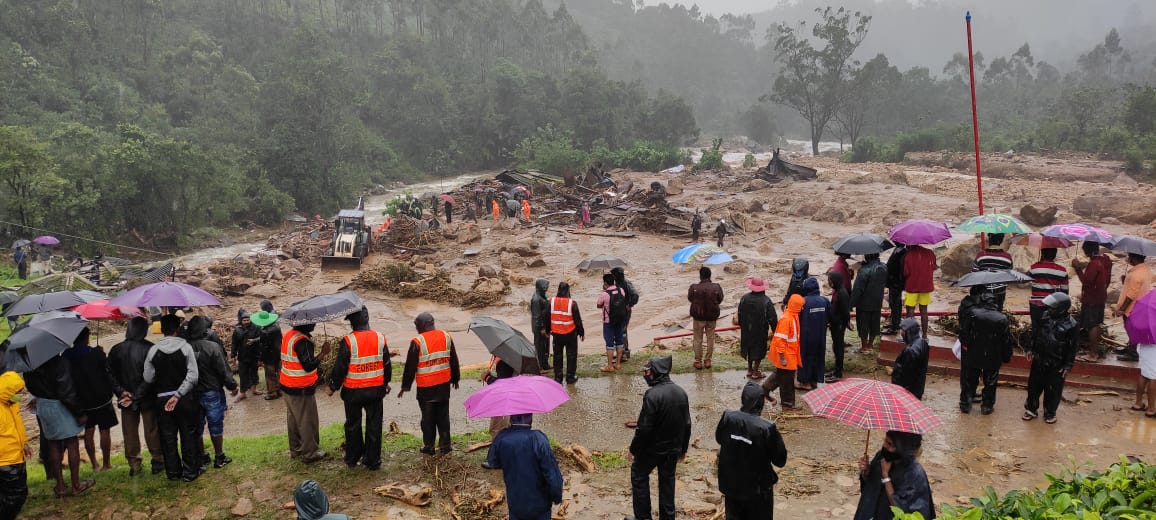Expert advice: Get local bodies involved in mapping even ward-level vulnerability; totally restructure the KSDMA.

Scene of the Pettimudi landlside, one of the biggest in the recent history of Kerala, that occurred on 6 August, 2020. (KA Shaji/South First)
While climate change and deforestation can be held responsible for Kerala acquiring the dubious distinction of becoming the “landslide capital of India”, the state itself must shoulder some of the blame.
Despite clear advice from experts, it has failed to, one, compile reliable vulnerability data or, two, set up an effective real-time warning system.
The state has witnessed flash floods and landslides even in August — usually the month the monsoon slowly eases up — as unseasonal torrential rains continued unabated in districts like Idukki, Pathanamthitta, Kottayam, Wayanad, Thrissur, Kannur and Kozhikode.
Several areas in the hilly regions of the state received over 15 cm of rain in just the last few days, causing fresh landslides. In the most recent incident, five members of a family were killed on Monday, 29 August, when a landslide swept away their house in Idduki’s Thodupuzha.
Science and Technology Minister Jitendra Singh told the Lok Sabha on 28 July that Kerala accounted for 2,239 of the 3,782 “significant landslides” recorded in the country between 2015 and 2022.
That is, 59.2 percent of all landslides in India occurred in a state that accounts for just 1.18 percent of the total land area of the country.
According to S. Sreekumar, a disaster risk consultant with the Kerala Institute of Local Administration, the state witnessed only 295 landslide-related casualties between 1961 and 2016 — a span of 55 years.
In the six years since, 374 people have been killed in landslides, according to data available with the Kerala State Disaster Management Authority (KSDMA).
“Ever since the devastating floods of 2018, the state has witnessed an alarming increase in the extent of deaths and damages,” Sreekumar told South First.
Across the state, the monsoon calendar has been witnessing a discernible change. As a result, apart from August witnessing heavy rains, there are more instances of high-intensity cloud bursts concentrated over smaller areas that trigger massive landslides.
Climate experts said the state has failed to take proactive measures to identify vulnerable areas at the micro-level. Instead of merely acting to mitigate the impact of rain-related disasters, they said the government must immediately map micro-level vulnerability across the state.
Even in Thodupuzha, where the latest landslide took place, there was no real-time information on the possible intensity of the rains — this, despite the fact that the area was identified as landslide-prone many months ago. Families in the area received no advance information on safety measures in the event of high-intensity rain.
Land and disaster management expert Dr KG Thara believes that the state’s local bodies should be immediately entrusted with the task of undertaking comprehensive, ground-level vulnerability mapping. She recommended even ward-level mapping as the situation was becoming more alarming by the day.
The experts have also called for a massive restructuring in the nature and composition of the KSDMA. In an RTI reply in April this year, the state’s nodal agency for disaster management said it lacks details on past landslides.
“This itself points to the precarious situation in the state. The KSDMA must be revamped with experts who can act swiftly on the prevailing challenges,” SP Ravi of the River Research Centre at Chalakudy told South First.
Ravi said the mapping would help people understand how to use the sloped terrain more sustainably to prevent disasters.
According to Dr K V Thomas, a former scientist with National Centre for Earth Science Studies, rubber monocropping that is prevalent in the state’s high-range areas is a significant contributing factor for landslides.
“Rubber trees are incapable of holding the soil during incessant rains. There is a need to plant and grow creeper vegetable plants as inter-cropping in rubber plantations to avoid soil slipping, Thomas told South First.
He said that they, along with stone quarry operations and unscientific construction activities, aggravate the climate crisis in the Western Ghat districts of Kerala.
According to Sreekumar, construction work has continued unabated even in vulnerable areas with the tacit support of authorities. He said road and culvert works must take into account possible challenges from flash floods and landslides. The “unscientific construction mechanism” in the state only adds to the problem.
Thomas also felt field surveys and mappings will help facilitate evolving mitigation measures, something stressed by CK Vishnudas, director of the Hume Centre for Ecology and Wildlife Biology, as well.
The mapping can focus on changes in land-use patterns, mainly in the hill regions, Vishnudas said, even as people in highly susceptible areas are shifted to safer places during the rains. And farmers should be given real-time data on the weather.

Jul 26, 2024

Jul 26, 2024

Jul 26, 2024

Jul 25, 2024

Jul 25, 2024

Jul 25, 2024